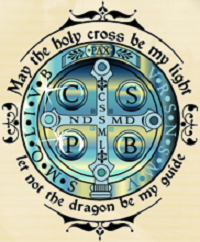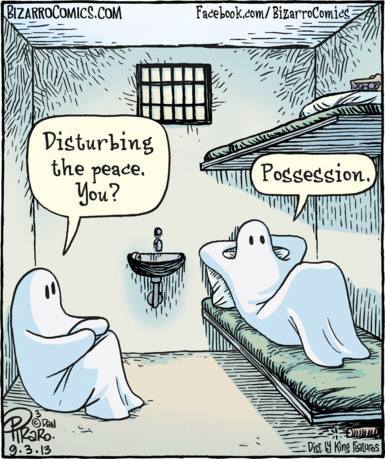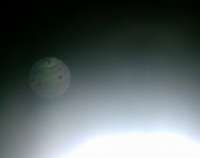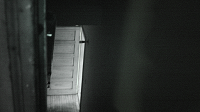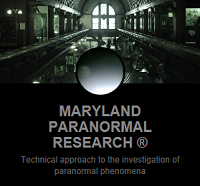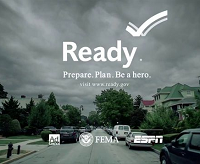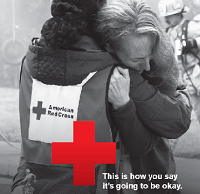Paranormal Research FAQ
The Abridged Maryland Paranormal Research® FAQ (Frequently Asked Questions)
A ghost is a popular term for a discarnate (spirit) being. A common dictionary definition usually runs along the following lines:
ghost noun \ˈgōst\
a disembodied soul; especially: the soul of a dead person believed to be an inhabitant of the unseen world or to appear to the living in bodily likeness (Webster)
Parapsychology views ghost encounters through the lens of psi, which refers to the mind’s capacities to transfer information (extrasensory perception), affect the environment (mind-matter interaction) and for post-mortem survival
A ghost is most likely to be experienced as a “sensed presence” through “imitative sounds” or speech, scents, electromagnetic anomalies, dreams, meaningful coincidences, displacements of objects, or physical contact
Sometimes ghosts are visually experienced in the form of an apparition, which usually are representations of living or deceased persons. According to surveys, apparitional encounters in most cases involve recognized persons, known to the individuals who are perceiving them. Apparitions often appear realistic and life-like
Classical parapsychology considers apparitions as “thought transferences” or “idea patterns” that somehow are in a external visual form. Sometimes the thoughts are memories (such as replays of battles and battlefield scenes). In other instances, experiences are more communicative or personal
• One leading psychical researcher, F.W.H. Myers, regarded apparitions as evidence of a “persistent personal energy” that existed in a “meta” space. However, the materiality (or physicality) of apparitions remains an unsettled question
From Tyrrell, G. N. M. (1953), the varieties of apparitions are: living agency; crisis; post-mortem; and haunting
• From surveys and case collections, most apparitions are non-recurring. They often are of recognized persons who: appear in moments of crisis or danger (crisis apparitions); are deceased (post-mortem apparitions); or are seen in end-of-life visions
• Haunting apparitions are recurring. They often are of unrecognized persons and have an affinity for a particular location. These types of haunting apparitions were called ghosts according to Tyrrell
In present times, ghost experiences are best described as sensed-presence and/or apparitional encounters
The survival hypothesis in parapsychology is the notion that the human personality (or elements of the human personality) can survive bodily death at least for a time. Evidence for post-mortem survival comes from the study of various classes of phenomena:
• Mental Mediumship
• Reincarnation (past-lives experiences)
• After Death Communication experiences
• Nearing Death Awareness experiences
• Near-Death Experiences (NDEs)
• Ghosts, Poltergeists and Hauntings
As a science, parapsychology stands apart from religious, esoteric or mystical practices and does not comment on the greater questions of spirituality, such as whether we possess a soul or what is the nature of the next world
Apparitional Experiences: A Primer on Parapsychological Research and Perspectives, WILLIAMS, VENTOLA, WILSON (2010) https://t.co/FwFQRShwes
— Maryland-Paranormal (@maryparanormal) March 24, 2016
Q: What is a Haunting? What are the Types of Hauntings?
Hauntings involve recurring apparitional experiences in a fixed location. Parapsychology researchers Gauld and Cornell (1979) found that hauntings involved recurrent phenomena that are place-centered, persisting on/off for several years, often occurring at night. The principal activity in hauntings involved “imitative noises”
Using the Gauld and Cornell case collection, researchers Alvarado and Zingrone (1995) found that hauntings are “elevated by their apparitional content”
Many ghost hunters identify two basic types of hauntings:
• Residual hauntings appear to be a replay, imprint or projection of events that have occurred at some location. These hauntings are popularly thought to be associated with emotionally charged events (e.g. a battlefield) and are consistent with parapsychological theories on place memory. In this form of haunting, agents do not interact with observers or occupants
• Intelligent hauntings involve purposeful activity. Intelligent hauntings can involve apparitions, speech, sounds, scents, movement of objects or even physical sensations or contact. The agent appears to interact with, or is attempting to interact with, observers or occupants. Because of apparent purposeful interaction, this form of haunting is more supportive of the survival hypothesis
Poltergeists involve manifestations of unexplained kinetic activity to include pronounced object movements and displacements or unexplained patterns of sound, such as knocking
• The term poltergeist is German for “noisy or unruly spirit.” Unlike hauntings which can span long timeframes, poltergeist activity is usually short-lived and intense
• Modern studies of the phenomena indicate it is oftentimes person-centered and reflects specific psi capacities known as psychokinesis (pk), a form of mind-matter interaction
• Poltergeist experiences appear closely related to the stress levels of the focus persons they are connected with. When the underlying stresses go away the activity ends
• However is not uncommon for poltergeist activity to accompany hauntings
After-Death Communication (ADC) are sensed-presence or apparitional encounters that occur when someone is seemingly contacted directly by a family member or friend who has died
• Unlike hauntings which are place-centered, ADC are person-centered involving connections with deceased loved ones
• ADC are somewhat more prevalent among widows and widowers, but they can occur in any close relationship
• ADC are often mistaken for hauntings, however, ADC activity tends to be shorter-lived or occasional
• ADC tend to be healing experiences that help percipients to process grief of loss
Poltergeist Phenomena: A Primer on Parapsychological Research and Perspectives, WILLIAMS, VENTOLA (2011) https://t.co/r1UGILmplB
— Maryland-Paranormal (@maryparanormal) May 14, 2016
Q: What are Electronic Voice Phenomena?
Electronic Voice Phenomena, or EVP, refer to electronically generated sounds that resemble speech, but are not the result of intentional voice recordings or renderings. EVP often provide the most compelling evidence for “drop-in communicators” and potentially for hauntings if the content suggests location affinities
EVP have been technically realized ever since the invention of telephony. Some of the more interesting instances of conversational EVP appear to involve anomalous telephone contact
An early pioneer, parapsychologist Konstantin Raudive, popularized the notion that EVP were communications with discarnate people in his 1971 entitled “Breakthrough.” Shortly thereafter, the specific term, EVP, was coined by Peter Bander in 1973
Sarah Estep, who founded the American Association of Electronic Voice Phenomena in Severna Park, Maryland, popularized the EVP classification system originally developed by Raudive, that is used by paranormal investigators today:
Class A: Messages that can be clearly heard without the assistance of headphones; listeners agree on message content
Class B: Messages that require careful listening to discern message content, usually with the assistance of headphones; listeners will not always agree on message content
Class C: Messages that require filtering and amplification, requiring the assistance of headphones; message content may not be fully discernable
Critics of Konstantin Raudive faulted him for an uncritical approach to EVP research and for mistaking radio broadcasts or background noise for EVP in his recordings. These legacies continue to overshadow present-day EVP research.
However modern professional sound components, to include preamplifiers/mixers, are engineered to reject radiofrequency interference and unwanted background noise. Moreover signal conditioning techniques using bandpass or digital noise filtering can attenuate undesired frequencies or artifacts.
Understanding Anomalous Telephone Contact (ATC) Phenomena or Telephone Calls From the Dead https://t.co/LOZFqQXFy3 #parapsychology #evp #psi
— Maryland Paranormal (@marylandpara) March 22, 2017
A related term, Instrumental Trans-Communication (ITC), refers to communication with agencies through any sort of electronic device/medium such as tape recorders, fax machines, television sets or computers. EVP are a trans-audio form of ITC.
The most common ITC devices employed by paranormal investigators include the P-SB7 (Spirit Box) radio and the Ovilus. Both devices provide results in real time.
Because these devices introduce white noise, radiofrequency artifacts or generate synthesized phonemes of speech, they are considered to have low evidentiary value. However, radio methods for ITC date back to 1949 with the direct radio voice experiments hosted by Marcello Bacci
The consensus view from field research is that EVP primarily are electromagnetic phenomena in the audio frequency range (20hz-20khz). Some researchers prefer to demonstrate this through pure electromagnetic induction methods or direct audio coupling with induction sensors, pickups, or diodes.
Voice prints and linguistics analysis can be used to identify the phonetic, syntactic and semantic components of the speech in question. Oftentimes voice prints of EVP have formants but lack harmonics making them sound hollow.
Automated speech recognition capabilities also show promise for removing subjectivity from audio analysis. Accuracy, although not perfect, will improve for paranormal research use-cases.
Maryland Paranormal Research® collects audio using conventional and induction techniques. We prefer audio findings involving contextually relevant, direct, specific and sentence and/or phrase-length responses to questions and controls. We also strive to present EVP evidence that is well above the electronic noise floor.
Retrospective on the research of Konstantin Raudive. Excerpts from "Breakthrough" (1971) and original EVP samples https://t.co/zLKrxnxxz7
— Maryland-Paranormal (@maryparanormal) July 1, 2016
Q: Can Ghosts be Seen, Heard or Experienced only at Night?
No. As spontaneous experiences, ghosts, poltergeists and hauntings activity can occur (and have occurred) at any hour
While most haunted activity is reported to occur at night, most apparitional experiences occur during daylight or in normal lighting conditions. Poltergeist experiences are more related to the stress levels of the focus persons they are connected with
Many ghost hunting groups prefer to investigate at night. Some of this owes to ghost folklore. An example is the witching hour, which refers to the time of day, generally past midnight or 3AM
There are some practical reasons for conducting paranormal investigations at night. Night conditions minimize man-made background sounds, movement, and electromagnetic influences or noise from various appliances
There may also be environmental rationales for investigation during night conditions. At night, the ionosphere expands, this expansion is conducive to the propagation of some forms of electromagnetic energy (e.g. radio waves).
However, some investigators would prefer not to limit themselves only to night conditions but instead to investigate phenomena within the timeframes reported by clients.
Petrow, S. (2017, Jul 23). At the end of her life, my mother started seeing ghosts, and it freaked me out. WAPO. https://t.co/jimpGRu0yR
— Maryland Paranormal (@marylandpara) July 24, 2017
Q: Can You Prove the Existence of a Ghost or a Haunting?
The existence of ghosts derives from the larger question of whether the human personality (or elements of human personality) survives bodily death.
Parapsychology regards post-mortem survival (of consciousness) as unproven
• Lines of research within survival include reincarnation, near-death experiences, nearing death awareness, mental mediumship, after-death communication as well as ghosts, poltergeists and hauntings
Proving a proposition depends on the standard of evidence applied
• Proof to a scientific standard requires results that are well beyond chance outcomes. Proof to the highest legal standards requires evidence that is beyond reasonable doubt
• If a lesser standard of proof (i.e. preponderance of evidence) is applied then the case for psi and survival has been well evidenced through over a century of case, field and laboratory research
Haunted activity involves transitory and low-observable events, with no unambiguous signatures. While spontaneous experiences cannot be reliably replicated in laboratory settings that doesn’t mean they are not real
Researchers study these experiences through case collections and surveys. Natural Language Processing provides new statistical tools to find meaningful insights, inferences and patterns across these encounters
If ghosts are thoughts, memories or “idea patterns” indicative of post-mortem agency involving transference of information and/or mind-matter interaction, then field research could explore convergent indications of communication, location effects and personhood
Some types of spontaneous experiences involving survival are more commonly encountered than others
• An After-Death Communication (ADC) experience occurs when someone is seemingly contacted directly by a family member or friend who has died. ADC experiences are somewhat more prevalent among widows and widowers
• Since most apparitional encounters involve recognized persons known to their percipients, it is reasonable to expect that ADC encounters are more common than hauntings, although they are often mistaken for hauntings
The late Gertrude Schmeidler advanced a method for finding location effects in buildings with haunted reputations
• The method attempted to ascertain whether experiment participants, some of whom were psychics or mediums, could sense haunted areas within these structures at rates above mean chance outcomes
• Random Event Generators (REGs) might also provide indications of location effects in haunting or ADC contexts, although the exact sources (or agencies) for psi-functioning cannot be known
• Data acquisition systems and sensors that continuously monitor environmental conditions can be used to explore physical correlates to location or communication effects
Instrumental TransCommunication (ITC) can provide convergent, albeit fragmentary, evidence of “drop-in” communication and personality
• Evidence of communication requires information transfers that are reasonably: clear; complete; and meaningful (i.e. do frames and metaphors make sense?). Proof of communication also requires demonstrating structure to include the phonetic, syntactic, semantic and discourse aspects of language
• Evidence of personhood reasonably requires: identity; consistency (in expression or vocal patterns); and connectedness (shared experiences). Evidence of personhood may be more likely encountered in ADC contexts where motivations to connect perhaps are strongest
In the field, the end goal remains to find convergent evidence of post-mortem agency and psi-functioning through effects. Meanwhile discovery and exploration better describes what paranormal research does
In the end, substantial numbers of people may not need to be convinced of the existence of ghosts. According to various polls anywhere from a third to a majority of Americans believe that ghosts exist
Random Event Generator Outcomes in Dundalk Historic District Ghost Expedition: Support for a Consciousness Bridge? https://t.co/YVyoIiwEme
— Maryland Paranormal (@marylandpara) October 5, 2017
Q: I Think My Home is Haunted. What Should I Do ?
As much as one can under stressful circumstances, try to calmly observe the ongoing situation. A haunting involves recurring and observable and seemingly unexplained events.
Keep a journal to document unexplained events, taking note of where and how often they occur and in what forms (sounds, speech, scents, apparitions, object movements/displacements, unusual temperature shifts and electromagnetic disturbances, etc).
There may be natural explanations for some seemingly paranormal events:
• Rustling sounds in an attic may be an animal. Cracking sounds in a basement often owe to the expansion and contraction of wood or ceramics with changes in relative humidity.
• Exposure to harmful invisible gases (such as carbon monoxide (CO), carbon dioxide (CO2) and radon) can have adverse health consequences and symptoms (such as headaches, dizziness, weakness/fatigue and nausea) that are perceived to be paranormal in origin, but in fact are not.
• Indoor exposure to black mold can lead to nasal, eye or skin irritation and in some cases result in respiratory issues.
• Rashes like hives can arise as a consequence of the body’s adverse reaction to allergens such as certain foods, food additives or medications.
• Insect or spider bites and stings can also cause rashes, blisters or other lesions that can lead to skin infections or hair loss if these areas are scratched. Some bites can result in muscle cramps, nausea or vomiting.
• Prescription medications, in particular psychotropic medicines while improving the quality of many lives, can have side effects and/or interactions resulting in sleep disturbances, agitation and nausea.
• Insufficient electrical insulation may entail higher than normal electromagnetic fields (EMF) in a client’s home. Exposure to elevated EMF levels may affect sleep patterns, and may suppress production of melatonin, which controls the sleep-wake cycle.
• Infrasound cannot be heard, but it can be felt. At levels above 48 decibels, infrasound is believed to induce feelings of anxiety, stress, restlessness and perceptions of paranormal phenomena.
If there are no apparent plausible and natural explanations for what appears to be haunted activity, then you should request a paranormal investigation.
A paranormal investigation involves a search for answers and not just a search for ghosts
Exploring Nursing Ghost Stories through Machine Learning: Topic Discovery with Latent Dirichlet Allocation #parapsychology #nda #machinelearning #ghosts #pythonhttps://t.co/H2xZ3VS79U
— Maryland Paranormal (@marylandpara) April 13, 2018
Q: How Do I Find a Paranormal Investigation Group? What Services Will They Provide ?
There are a number of online directories for paranormal investigative groups. An excellent resource is ParanormalSocieties.com. Most groups operate on a pro bono basis i.e. they do not charge for services provided.
You will want to ascertain the overall experience level of the team, and whether the group has done background checks on members. You will want get a sense of whether the team is sufficiently equipped to verify the events in question.
Importantly, you will want to get a sense of the investigation team’s methods. Does the group have a techical approach relying on instruments and sensors ? Does the group mainly rely non-techical sensing means such a psychics, empaths, or sensitives? Both have advantages and disadvantages. Many groups have a technical orientation; however, some adopt hybrid approaches.
Many groups also have historians who can find documentation on former residents as well past uses/events in connection with the property. The Enoch Pratt Library has provided a guidebook “Researching the History of Your House” with tips, online resources for maps, records and other archives.
In any event, the group should be able to clearly communicate its findings, which can take several weeks to compile.
The paranormal investigation group may request that you sign legal forms. One critical form is an indeminity agreement (which protects both parties in the event of damage or injury). Some underwriters provide groups with letters of insurance providing for damages up to a specified amount.
There may (or may not) be an information release allowing the group to post investigation media and findings, under the constraints you allow. For complete privacy, you can insist the group not disclose any investigation results.
Buy a Haunted House? Most Would Consider It, Survey Says http://t.co/gJoSuD3Dfw via @aolrealestate
— realtor.com (@realtordotcom) October 24, 2013
Q: OK. I Have Documented Ghosts and They are a Problem. What Can I Do ?
The techniques will depend on the context of the situation and some are primarily derived from folklore. An excellent reference featuring advice from a noted psychic is “How to Remove a Ghost” appearing in an article from the Chicago Tribune
Miles, T. (2016, Oct 27). Haunted Houses Are About More Than Just Ghosts. [Ghostland, by C. Dickey] NY Times https://t.co/TdybtO2Ggr
— Maryland Paranormal (@marylandpara) August 25, 2017
A simple folklore remedy that is considered reliable is to communicate with the ghost and ask the perceived entity to leave
Prayer and religion are powerful levers. A house blessing performed by clergy ritualizes the process of helping a ghost to move on
An gifted and/or experienced psychic can be a very effective option in communicating with spirits and coaxing them to move on
There are other folkore remedies such as applying holy water, sand, rice, dry salt in the active or haunted areas as well windows and doorways. House cleansing rituals involve the application of burning sage or other scents.
Consider removing objects from the home an entity may be perceived to have attachments to
Another remedy, seen in various cultures, involves the placement of outward facing mirrors at (or behind) doorways, with the intent of deterring ghosts or orienting possible ghost portals away from the home
A science-based remedy offered by paranormal researcher Joshua P. Warren involves placing humidifiers in affected areas. Cool, dry conditions are said to contribute to haunted activity as they foster the cumulation/transfer of static electrical charges. Moisture and humidity increase the dielectric strength of air
Folklore remedies perhaps may have similar electrical resistance effects. Many materials above were examples of electrical insulators. Depending upon wavelengths, mirrors can absorb, diffract or reflect electromagnetic energy. Burning sage creates smoke and ash that perhaps has insulating effects
In parapsychology, the above acts of prayer, ritual and communication represent forms of intentionality which involves the direction of mental states (e.g. thoughts, beliefs, desires, hopes) towards some object(s), person(s) or state of affairs
Possible examples of intentionality may be seen in apparent instances of distant or mental healing, the placebo effect and in cases of apparitions of the living. That folklore remedies seem to work may possibly owe to psi functioning
There are other parapsychological contexts worth considering depending on who may be central to the experiences
• If affected persons are transliminal (very sensitive to environmental stimuli) or have unrealized mediumship abilities, paranormal types of encounters may be a lifelong condition
• Poltergeist experiences are oftentimes related to the stress levels of the focus persons they are connected with. When the underlying stresses go away the activity ends
• If there are after-death communication (ADC) encounters involving sensed-presence or apparitional experiences connected with deceased relatives or friends, activity will be shorter-lived or occasional
Q: I See Something Very Unusual in My Photo. Is it a Ghost ?
It is quite rare to capture ghosts in photo or video imagery. Digital image artifacts perceived as ghosts oftentimes have an explainable origin.
Modern day digital cameras and camcorders use CCD or CMOS type image sensors. Processors in these sensors translate images into digital data. The resolution quality of the digitized image is expressed as a pixel count.
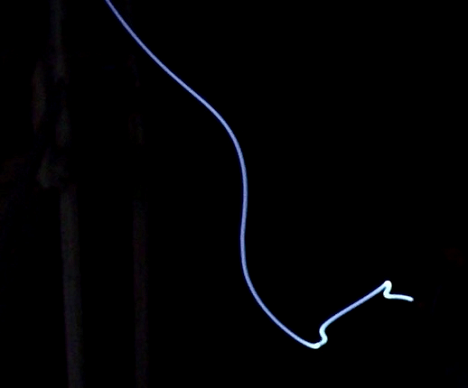
|
Light trail (possible insect) due to low light/low shutter speeds. Source: SSPRI
Analysis should carefully review fairly commonplace artifacts on digital imagery such as orbs, mists, spirals, flying rods, and moving trails, which should not be automatically elevated to paranormal significance, especially if the image was taken in low-light conditions, with long exposure times and a flash.
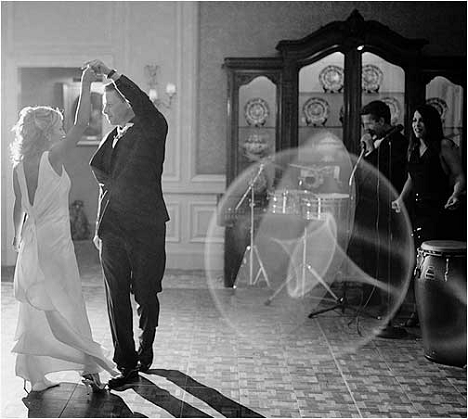
|
Lens flare from reflection off internal lens surfaces. From: Luminous Landscape
These artifacts often result from the effects of light and/or exposure times on dust, pollen or grain, moisture, camera straps, insects, as well as from hand movement. Lens flare and diffraction produce artifacts as well, including orbs, when the camera is directly pointed at a light source.
Insects crawling on/around video camera lenses can create the illusion of ghostly apparitions as demonstrated in the example below. In such instances, the mystery object is never observed to move behind anything in frame.
ARCHIVES of Maryland Paranormal Research ® #hauntedmaryland Apparition (or Insect ?) on Hotel CCTV http://t.co/GwIHTkpFhQ
— Maryland-Paranormal (@maryparanormal) March 5, 2014
Because digital imagery is easily manipulated, it is necessary to have the original image and associated EXIF (image file) data for evidence/peer review.
For an unaltered image, EXIF data provide the model and make of the camera, aperture, focal length, exposure times and whether a flash was used. Image file data for a modified photo will lack such details and may indicate the software used to create the image.
Varieties of ghost hoax applications available on smartphones remove original EXIF data while creating suspect images. A commonly encountered hoax is the “ghost girl” photograph
[APPARITION?] Ghost Girl in Utah May 2012 #hauntedmaryland #tumblr Hoax image created by the "Ghost Capture" app http://t.co/5gPyVFamxK
— Maryland-Paranormal (@maryparanormal) January 1, 2014
Parapsychology field research suggests paranormal imaging may require psi capacities. Thoughtography is an ability to impress images onto photographic film by the power of intentional thought
The late Ted Serios, a hotel worker from Chicago, was an adept at thoughtography
He produced hundreds of photographs on Polaroid film in controlled experiments conducted by the parapsychologist Jules Eisenbud from 1964-1967
Images from those experiments have been archived at the University of Maryland, Baltimore County
UMBC Special Collections: Jules Eisenbud Collection on Ted Serios and Thoughtographic Photography #parapsychology https://t.co/NnPwZY8yG4
— Maryland Paranormal (@marylandpara) October 15, 2016
Q: I Want to Form a Paranormal Investigation Team and Hunt Ghosts. How Do I Start ?
There is a difference between paranormal investigations and ghost expeditions (hunts). In a paranormal investigation, you are working on behalf of a client to examine claims or experiences of haunted activity. In a ghost hunt, participants are legend tripping and scouting for paranormal activity at reputed haunted locations
Although similar equipment/skills are used in both, paranormal investigation requires a somewhat higher of level tradecraft/discipline as you must provide accurate findings to oftentimes very anxious and distressed clients
Paranormal investigation also requires basic science/mechanical understanding to recognize natural explanations for reported haunted activity
It helps to understand what parapsychologists have learned about ghosts, poltergeists and hauntings
It also helps to have limited familiarity with digital photography, along with sound and signal propagation as you review claims of the paranormal in video, still photographs and audio. Your team should also attempt to baseline the client’s environment (temperature, relative humidity, electromagnetic fields, etc) especially in the affected areas and sometimes this quickly solves investigation cases
Finally, paranormal investigation is an end-to-end process involving: case management; location surveys; legal releases (and if applicable insurance arrangements); client interviews/followup; and a collection plan/design that optimizes equipment on hand. The most time consuming aspect, but nonetheless critical, is evidence review and reporting
Insofar as most paranormal findings are audio, analysis and production requires audio editing software as well as programs that can display audio signals in the time and frequency domains. Signals analysis in the frequency domain may require use of an oscilloscope. For research purposes, would recommend examining voice prints for the phonetic signatures of EVP
Our preferred applications include Audacity, Wavepad, Spectrum Lab, Raven, and Praat. Garage Band is audio recording software for Apple/Mac systems. SONY Sound Forge is a premium audio production application. iZotope provides a suite of premium studio quality digital audio mastering applications as well
A paranormal investigation could entail limited historical research (e.g. genealogical, property etc.), so use your local historical society
Ghost hunts, by contrast, are usually just for fun, requiring little more than a camera or a voice recorder, and lots of patience. Your team might consider using ghost hunts as training events
Some ghost hunts require advance planning, especially for hazards at derelict locations (asbestos, sharp objects, chemicals, mold. etc.). You will need to get legal permissions for access and possibly make security arrangements
Many locations popularized through paranormal television shows are tourist locations that require fees for location access (e.g. Hill View Manor)
When the paranormal world meets the academic world http://t.co/XIaM2AALZt
— The Atlantic (@TheAtlantic) February 10, 2014
Q: Are There Any Science Foundations for the Paranormal ? How Can These Events Happen ?
Through case collections, surveys and experimental research, parapsychology has maintained that the mind can obtain information or interact with the environment beyond known inferences. These human abilities are not supernatural but rather are part of the natural system having an evolutionary origin
Paranormal occurrences can seem to defy explanation and our understanding and observation of them is incomplete. Nonetheless, psi functioning doesn’t contradict any known laws of science. Moreover, scientific laws appear to bound paranormal event horizons even if they do not explain them
Physics is the science of matter and energy and their interaction and is known as the fundamental science. Classical physics consists of mechanics and electromagnetism. Modern physics consist of relativity and quantum mechanics. All of these branches are necessary for gaining insights into paranormal phenomena
Classical Mechanics is concerned with the motion of bodies under a system of forces. The foundations of classical mechanics are expressed in Newton’s laws of motion involving the core concepts of force, mass, acceleration, velocity, and momentum
The Law of Conservation of Energy is derived from Newtonian principles and states that energy is conserved over time in closed systems, specifically that energy is neither created nor destroyed. If conservation of energy did not hold, paranormal events would practically be perpetual or unbounded
Mechanics remains central to studies of poltergeist and psychokinetic phenomena. Field research, for example, has indicated that the majority of poltergeist/pk events tend to occur within 15 feet of focus persons
Classical electrodynamics perhaps carries the greatest potential to explain paranormal phenomena. In daily life, electromagnetic energy is used to convey and carry information.
Oscillations of charged particles produce electromagnetic fields (EMF) which propagate from points of origin in the form of waves. In a vacuum, these waves travel at the speed of light.
EMF exists in a wide spectrum of wavelengths to include (in order of increasing frequency) radio waves, microwaves, light (infrared, visible and ultraviolet), x-rays and gamma rays.
The most common source of EMF in homes and work spaces will come from electricity supplies and appliances powered by them. These kinds of EMFs carry a fundamental frequency of 50 or 60 hertz (hz)
Fluctuations and/or disturbances in electromagnetic fields appear to accompany paranormal events. Electronic voice phenomena (EVP) are possibly a form of modulated EMF containing/carrying information.
The foundations of classical electrodynamics are described by Maxwell’s Equations, which provide a unified framework of four laws that state the fundamentals of electricity and magnetism
Previously electromagnetic fields were thought to be tethered to the currents or charges that produced them. Maxwell demonstrated that electromagnetic waves could propagate indefinitely far from their origin
In electromagnetism, conservation of energy appears in the form of the inverse square law as the energy density of the wave dissipates the further it travels from the source
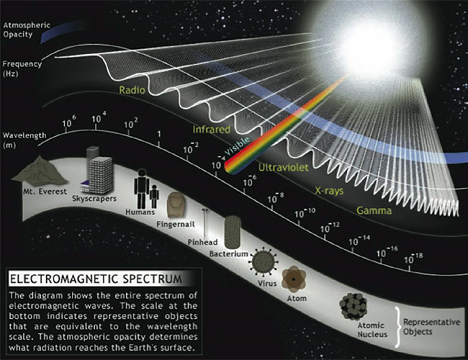
|
Source: NASA and University of California, Berkeley
The laws of classical mechanics apply only to inertial frames of reference. However bodies are always in motion relative to one another. Although an absolute inertial reference frame does not exist, the laws of classical mechanics hold across simple linear transformations of reference frames with respect to time
At one time physics briefly adhered to the discarded notion of aether as an absolute reference frame. Aether was thought to consist of a sea or fabric of invisible electromagnetic waves
However experiments would later demonstrate that the speed of light is independent of the motion of its source. Hence an observer accelerating toward the speed of light would not experience events in space and time the same as a stationary observer
Einstein’s Special Theory of Relativity was developed to account for motion at any speed up to the speed of light. The theory implies a range of non-intuitive but verified consequences to include:
Time Dilation. Time expands (slows down) for an observer in motion accelerating toward the speed of light
Mass-Energy Equivalence. Matter and energy are the same as exemplified by the rest energy (or mass energy) equation (E=mc²). A small amount of matter contains enormous potential energy
Relativistic Energy. The energy of a system is composed of rest energy (mass energy) and motion energy (momentum energy). Total energy in a system is conserved from the reference frame of any observer although total mass may not be conserved
A core implication for paranormal research is that the Law of Conservation of Energy always holds. Psi-functioning does not contravene the laws of mechanics, electrodynamics and relativity
Paranormal events and event horizons may be made possible through borrowed energy
The electromagnetic spectrum contains information carried and conveyed through electromagnetic fields and waves
Psi-functioning resulting in physical effects (kinematic, thermal, or electromagnetic) is ultimately constrained by physical laws
Moving Milk Bottle Cap Mysteries: Ghosts, Poltergeists, or the Ideal Gas Law?https://t.co/Ziy9uQF1SU
— Maryland Paranormal (@marylandpara) May 26, 2018
Q: Are Paranormal Events Explained by Quantum Physics?
Leading parapsychology researchers seem to think so. As the most successful explanatory framework in physics, quantum is the underlying physical reality of everything. In time it will likely change how we view nature itself.
Quantum mechanics is a branch of physics that examines phenomena at atomic and subatomic scales. Quantum objects behave differently than their molecular counterparts in the classical mechanics realm
Quantum objects exhibit wave and particle properties. And it is not possible to know the position and momentum of quantum objects at the same time. Quantum objects can tunnel through barriers
Entanglement. Quantum particles separated over vast distances can also inexplicably exhibit synchronized behaviors. Quantum Entanglement (also called quantum nonlocality) is a correlated interaction of quantum states between pairs of particles
Quantum entanglement can occur across arbitrarily large distances. Renowned physicist Albert Einstein referred to the phenomenon as “spooky action at a distance”
Research suggests large scale quantum entanglements are pervasive and indicate interconnectedness among things everywhere there has been interaction
Superposition. Due to a principle called superposition, quantum particles exist in every possible state at the same time
The Many Worlds Interpretation (MWI) holds that all possible states of a system simultaneously occur in a multiverse, composed of parallel independent universes. This view suggests that all possible histories and all possible futures are real
The Copenhagen Interpretation is the traditional view which says while all states are possible, the object takes the state in which it is observed. Consequently, an object doesn’t exist in all states while it is being observed. And nothing is real unless it is observed
The Transactional Interpretation of Quantum Mechanics is a more recent interpretation where present states entail a handshake between the past and future possibilities resulting in transfers of energy. Reality does not require an observer
Quantum Suicide: How to prove the multiverse exists, in the most violent way possible http://t.co/iOvgR3bg
— io9 (@io9) March 8, 2012
The elementary particles and fundamental forces of quantum physics are described in the Standard Model. Particles are characterized in terms of their spin, charge and mass
There are four fundamental forces in the universe: the strong force, the weak force, the electromagnetic force, and the gravitational force
These forces result from energy transfers during exchanges of force carrier particles, broadly called bosons. With the exception of gravity, each fundamental force has its own corresponding boson(s):
The strong force (which ensures the stability of matter) is carried by the gluon, the electromagnetic force (which holds matter together) is carried by the photon, and the W and Z bosons are responsible for the weak force (which governs radioactive decay)
The Higgs boson recently confirmed in Large Hadron Collider (LHC) experiments is a short-lived boson responsible for transferring mass to other fundamental particles via a mechanism called the Higgs-field
The building blocks of matter are particles called fermions which occur in two types, quarks (which bind together) and leptons (which can exist independently)
Quarks combine in triplets (baryons) and doublets (mesons) to form the nucleus of atoms (protons and neutrons)
The electron, muon and tau are lepton particles that have an electric charge and sizeable mass. Neutrinos (also called “ghost particles”) are leptons that carry no charge, possess very little mass, and can easily pass through matter
The Model of Pragmatic Information (MPI) is a notion inspired by quantum field theory that psi phenomena represent meaningful and self-organizing mental, social and physical entanglements
The MPI theory suggests that consciousness is foundational to our existence. This view was shared by the leading quantum physicist and Nobel laureate Max Planck
Quantum entanglement reveals invisible objects: http://t.co/e8f993KVeV
— National Geographic (@NatGeo) August 28, 2014
Q: What is Consciousness ? Does Consciousness Exist Outside the Body ?
Consciousness is defined in the dictionary as the fact of awareness by the mind of itself and the world. However it is not clear where the mind exists or even why it exists.
The mind-body problem is the age old question of the relationship between the mental and the physical realms. Dualism maintains a rigid distinction between mental and physical realms. Monism maintains there is only one unifying reality, one realm of being
What is Consciousness? Philosophy Behind the Mind [Survey article from Psychology Today] #tumblr http://t.co/6Plt54TzK4
— Maryland-Paranormal (@maryparanormal) June 29, 2014
Epiphenomenalism is the prevailing mind–body (monist) philosophy that regards mental events as dependent on physical functions. Consciousness is a product of neurophysiology of the brain. Under this view the mental realm reduces to the physical realm
The psychology of the mind was dominated by behaviorism through the first half of the 20th century. Unlike behaviors, mental events were not directly observable. Descriptions of the mind were avoided
The ascendancy of the cognitive revolution in the latter half of the century integrated research on cognition with neuroscience. Cognitive neuroscience views the mind as a complex system tied to the physical world through feedback, information and computation
MT @NatGeoBooks: How modern medicine is reinventing death as we know it. http://t.co/E8mm4YTHrA
— National Geographic (@NatGeo) September 3, 2014
Phenomenal consciousness (p-consciousness) are raw experiences (qualia) consisting of forms, sounds, sensations, emotions and feelings with our bodies. Access consciousness (a-consciousness) involves memory, reasoning, behavior control and introspection
The hard problem of consciousness is the problem of explaining why we have qualia (experiences), or why there is a “what it is like” for a subject. In essence it is the problem of explaining why we are not robots and why consciousness exists at all
The thought experiment illustrating the hard problem conceives an exact molecular replica of an individual. If it is possible that the replicant is “dark” inside, a zombie lacking phenomenal consciousness, then consciousness cannot reduce to the physical realm
http://t.co/ogVJ8kVD7V| Consciousness After Death: Strange Tales From the Frontiers of Resuscitation Medicine #tumblr http://t.co/KfUo0FJCel
— Maryland-Paranormal (@maryparanormal) June 29, 2014
Panpsychism is the view that the basic physical constituents of the universe have mental properties and that consciousness is universal. It is a notion found in ancient eastern and Grecian philosophy. Interest in panpsychism has revived due to the hard problem of consciousness
Varieties of exceptional (paranormal) experiences suggest but not prove dualism and that mind exists apart from the body
• Enigmas of near death experiences
• Varieties of dissociation/automisms
• Post mortem survival/psi phenomena
Leading thinkers in modern physics have regarded consciousness as foundational to reality, and certainly the observation of reality. Quantum physicist Max Planck reflected this sentiment in a 1931 interview with The Observer.
“I regard consciousness as fundamental. I regard matter as derivative from consciousness. We cannot get behind consciousness. Everything that we talk about, everything that we regard as existing, postulates consciousness”
Consciousness remains the hard problem and is something that cannot be precisely bounded or measured. It is either foundational or universal to being
Do Higher Dimensions Exist?: Accounts From Persons Who Had Near-Death Experiences (NDEs) https://t.co/XxZAkeu2ag #nde
— Maryland-Paranormal (@maryparanormal) February 3, 2016
Recommend reading includes:
Cardeña, E., Palmer, J., & Marcusson-Clavertz, D. (Eds.). (2015). Parapsychology: A handbook for the 21st century. McFarland.
Eisberg, R. M. (1967). Modern Physics. New York: John Wiley and Sons.
Gauld, A., & Cornell, A. D. (1979). Poltergeists. Routledge Kegan & Paul.
Irwin, H. J., & Watt, C. A. (2007). An introduction to parapsychology. McFarland.
Roll, W. G. (1972). The poltergeist. N. Doubleday.
Tyrrell, G. N. (1953). Apparitions (rev. ed.). London: Society for Psychical Research.
If you enjoyed this FAQ, help support our research on Patreon.

|
This content uses referral links. Read our privacy policy for more info
check out @maryparanormal FAQ page for some great information for beginner ghost hunters! #ghosthunting http://t.co/OPixwaOYp8
— ProMeasure (@pro_measure) December 3, 2013

